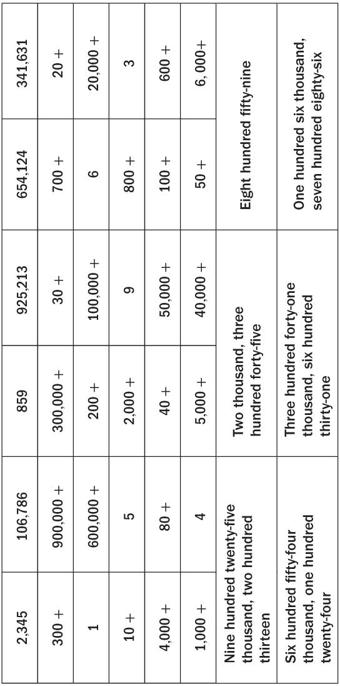Teaching the Common Core Math Standards With Hands-On Activities, Grades 3-5 (27 page)
Read Teaching the Common Core Math Standards With Hands-On Activities, Grades 3-5 Online
Authors: Judith A. Muschla,Gary Robert Muschla,Erin Muschla-Berry
Tags: #Education, #Teaching Methods & Materials, #Mathematics, #General

BOOK: Teaching the Common Core Math Standards With Hands-On Activities, Grades 3-5
8.75Mb size Format: txt, pdf, ePub
Closure
Discuss students' results.
Answers






- Comparisons may vary. Two correct answers are
 .
.
Number Form Cards
Number and Operations in Base Ten: 4.NBT.3
“Generalize place value understanding for multi-digit whole numbers.”
3. “Use place value understanding to round multi-digit whole numbers to any place.”
Background
An understanding of place value is essential to rounding numbers. To round a number, students must first find the digit to the right of the place they are rounding to. They must then follow the rules for rounding:
- If the digit to the right of the digit to be rounded is less than 5, the digit in the place to be rounded stays the same. Change any digits to the right of that digit to zero.
- If the digit to the right of the digit to be rounded is 5 or more, add 1 to the digit in the place to be rounded. Change any digits to the right of that digit to zero.
- If 9 is in the place to be rounded, and the number to its right is less than 5, 9 stays the same. Change any digits to its right to zero. If the number to the right of 9 is 5 or more, add 1 to the 9. Because
 change 9 to zero and add 1 to the digit to the left. Change any digits to the right of the rounded number to zero.
change 9 to zero and add 1 to the digit to the left. Change any digits to the right of the rounded number to zero.
Activity: Rounding Numbers
This is a two-day activity.
Working in groups, students will be given two numbers. They will create a poster on the first day and, using their poster as a visual aid on the second day, will explain to the class how to round the two numbers they were given.
Materials
Large poster paper; rulers; markers; crayons for each group.
Procedure
Day One
1.
Review the steps for rounding with your students. Provide some examples, such as the following:
- Round 375 to the nearest ten: 380.
- Round 6,436 to the nearest hundred: 6,400.
- Round 58,721 to the nearest thousand: 59,000.
2.
Explain that each group will be given two numbers, one that must be rounded up and one that must be rounded down. Students will detail the procedure for rounding each on poster paper and then present their work to the class.
3.
Suggest that students brainstorm ideas on how to design their posters before beginning work. To clarify their ideas, they should do a “rough” design on a separate sheet of paper first.
4.
Provide each group with two numbers. You may select numbers of your own or you can use these:
| 1. Round 8,576 to the nearest hundred. | Round 26,753 to the nearest ten. |
| 2. Round 4,684 to the nearest ten. | Round 73,165 to the nearest hundred. |
| 3. Round 9,029 to the nearest ten. | Round 91,484 to the nearest thousand. |
| 4. Round 14,783 to the nearest hundred. | Round 9,238 to the nearest thousand. |
| 5. Round 4,958 to the nearest ten. | Round 35,029 to the nearest thousand. |
| 6. Round 75,483 to the nearest thousand. | Round 6,294 to the nearest hundred. |
| 7. Round 95,951 to the nearest hundred. | Round 8,502 to the nearest ten. |
| 8. Round 42,075 to the nearest ten. | Round 8,146 to the nearest thousand. |
| 9. Round 54,899 to the nearest ten. | Round 4,816 to the nearest hundred. |
| 10. Round 19,843 to the nearest hundred. | Round 6,503 to the nearest thousand. |
Other books
Fall Into His Kiss by Jenny Schwartz
A Sound Among the Trees by Susan Meissner
The Death of an Irish Lover by Bartholomew Gill
Blink Once by Cylin Busby
Eveillez: Deny Your Blood Lust by Hussey, C.D.
Infringement by Benjamin Westbrook
A Dance of Death by David Dalglish
How Cassie Got Her Grind Back by Heather Rainier
The Queen of the Big Time by Adriana Trigiani
The World of Null-A by A. E. van Vogt, van Vogt

